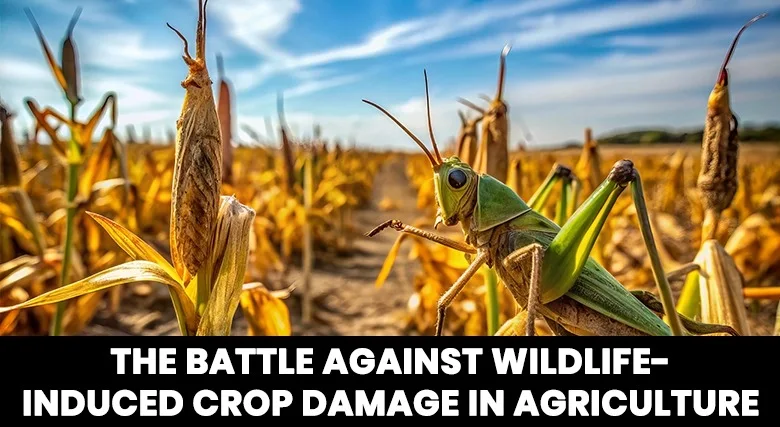- Get link
- X
- Other Apps
- Get link
- X
- Other Apps

Did you know, how much effort a farmer has to put in to grow one bag of grain? To grow crops, they have to work like tilling, fertilizing, sowing seeds, transplanting, Watering, Pest and Disease Control, Harvesting, etc. After waiting for rain for several months, the fields look bright and crops grow in abundance. Farmers have to completely depend on the weather and rain.
But despite of all efforts and precautions, many crops of farmers get ruined due to attacks by wild animals in many parts of the country. Especially in regions where agriculture borders are near forests or wildlife habitats, for example- The Himalayan Region, Rajasthan, Southern India. Elephants, monkeys, and wild boars are a major concern in these states. They are known to enter farms, damaging crops, especially near forested areas and wildlife corridors. This issue is not just about protecting yield; it is about sustainability, wildlife conservation, and the economic well-being of farming communities.
Challenges Arising from Wildlife Crop Damage
Wild animals keep wandering from forests to villages and fields in search of food. Due to this, they destroy the crops of many fields, which causes huge losses to the farmers, and loss of food, and sometimes these animals even carry out fatal attacks.
But there is no fault of these animals because they are also helpless because their habitat is being destroyed day by day, mainly due to deforestation by humans. As we move towards urbanization, we are clearing forests, forcing these animals to leave the forests and come to villages, towns, and farmland. Many times, they get injured while searching for food and even die in road accidents.
According to global studies, wildlife-related losses amount to billions of dollars annually. Birds, especially in paddy fields, consume substantial grain amounts during growth and harvest stages. For instance, in Asia and Africa, elephants can devastate several hectares of fields in a single night, leaving farmers with severe losses and deep distress, and in extreme cases, even leading some to commit suicide.
Causes of wildlife crop damage
Forest animals such as elephants, wild boars, deer, etc. migrate into the nearby agricultural fields in search of food and cause huge damage to the crops not only by eating but also by trampling the crops with their foot. In some areas, wild animals damage crops to the extent of 50-60%, and sometimes 100%. These are some of the reasons due to which wild animals come into the fields and damage the crops.
Seasonal shortages:
During droughts, floods, or cold winters, wild animals experience food shortages and move into crop fields, especially when they are close to forests or natural areas.
Monoculture Farming:
Planting a single crop over large areas makes fields attractive to certain wildlife, such as rodents or birds, which feed exclusively on those crops.
Poor Fencing and Barriers:
Many farmers lack effective physical barriers to prevent wildlife from entering their farms, especially in rural and remote areas. That's why farmers are not able to save their crops.
Traditional and Modern Methods for Mitigation
Farmers use a mix of old and new methods to keep wildlife away from their fields. Here are some common approaches they have tried, with different levels of success:
Age-old strategies -
Over generations, farmers have adopted a variety of preventive and defensive mechanisms. Framers use traditional scarecrows, often made from sticks, old clothes, and straw, which are placed in fields to scare away birds and small animals. They also use noise-making devices like empty cans, bells, or even firecrackers to make noise and scare off animals approaching their fields. Although these strategies are time-tested, they still have their limitations and sometimes contribute to environmental degradation.
Fences and electric barriers -
Physical barriers like traditional fencing, barbed wire, and electric fencing are commonly used to protect crops. While electric fences are quite effective, they are also costly and may not be affordable or practical for small-scale farmers.
Using Organic Repellents -
Organic repellents made from ingredients like chili, garlic, and neem have shown success in deterring certain animals. These repellents are safe for the environment and relatively affordable for farmers.
Technological Solutions -
New technologies such as drones, motion-activated lights, or sound and infrared cameras are now being used to monitor farms and keep out wildlife. Although these methods are effective, they can be costly for small farmers.
How can we balance conservation with agriculture?
Farmers are not facing this challenge alone; they are backed by communities, conservationists, and organizations collaborating to safeguard both crops and wildlife. The success of sustainable agriculture initiatives is often influenced by government support and financial resources. In our exploration, we'll look at how policies that support agricultural practices can align with wildlife conservation efforts.
Governments and conservation organizations work with local farmers to promote sustainable practices that reduce damage while preserving wildlife. This includes sustainable practices such as creating wildlife corridors, using natural barriers and promoting non-lethal deterrents such as motion sensors and repellents.
Governments and NGOs are increasingly funding research to understand animal behavior, develop new preventive techniques, and design strategies to reduce crop losses. By implementing wildlife corridors, offering compensation schemes for crop losses, and promoting sustainable agricultural practices. These initiatives aim to protect both the livelihoods of farmers and wildlife habitat.
As we strive for more sustainable agriculture, let's make sure our efforts include acknowledging and addressing the impact of wildlife on crop growth. We remain hopeful for a future where humans and nature coexist in harmony and balance. It is essential to continue researching and developing new methods of mitigation, as well as actively engaging with stakeholders to promote sustainable agricultural practices that benefit both humans and wildlife. We must shift from short-term fixes to creating sustainable, long-term solutions that ensure both wildlife and agriculture can thrive together.
- Get link
- X
- Other Apps

Comments
Post a Comment